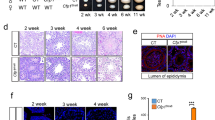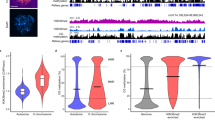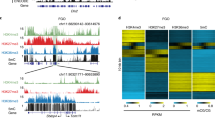Abstract
Epigenetic modifications of histones regulate gene expression and chromatin structure1,2. Here we show that Meisetz (meiosis-induced factor containing a PR/SET domain and zinc-finger motif) is a histone methyltransferase that is important for the progression of early meiotic prophase. Meisetz transcripts are detected only in germ cells entering meiotic prophase in female fetal gonads and in postnatal testis. Notably, Meisetz has catalytic activity for trimethylation, but not mono- or dimethylation, of lysine 4 of histone H3, and a transactivation activity that depends on its methylation activity. Mice in which the Meisetz gene is disrupted show sterility in both sexes due to severe impairment of the double-stranded break repair pathway, deficient pairing of homologous chromosomes and impaired sex body formation. In Meisetz-deficient testis, trimethylation of lysine 4 of histone H3 is attenuated and meiotic gene transcription is altered. These findings indicate that meiosis-specific epigenetic events in mammals are crucial for proper meiotic progression.
This is a preview of subscription content, access via your institution
Access options
Subscribe to this journal
Receive 51 print issues and online access
$199.00 per year
only $3.90 per issue
Buy this article
- Purchase on Springer Link
- Instant access to full article PDF
Prices may be subject to local taxes which are calculated during checkout




Similar content being viewed by others
References
Jenuwein, T. & Allis, C. D. Translating the histone code. Science 293, 1074–1080 (2001)
Zhang, Y. & Reinberg, D. Transcription regulation by histone methylation: interplay between different covalent modifications of the core histone tails. Genes Dev. 15, 2343–2360 (2001)
Noma, K., Allis, C. D. & Grewal, S. I. Transitions in distinct histone H3 methylation patterns at the heterochromatin domain boundaries. Science 293, 1150–1155 (2001)
Santos-Rosa, H. et al. Active genes are tri-methylated at K4 of histone H3. Nature 419, 407–411 (2002)
Bernstein, B. E. et al. Methylation of histone H3 Lys 4 in coding regions of active genes. Proc. Natl Acad. Sci. USA 99, 8695–8700 (2002)
Schneider, R. et al. Histone H3 lysine 4 methylation patterns in higher eukaryotic genes. Nature Cell Biol. 6, 73–77 (2004)
Wang, H. et al. Purification and functional characterization of a histone H3-lysine 4-specific methyltransferase. Mol. Cell 8, 1207–1217 (2001)
Nishioka, K. et al. Set9, a novel histone H3 methyltransferase that facilitates transcription by precluding histone tail modifications required for heterochromatin formation. Genes Dev. 16, 479–489 (2002)
Milne, T. A. et al. MLL targets SET domain methyltransferase activity to Hox gene promoters. Mol. Cell 10, 1107–1117 (2002)
Nakamura, T. et al. ALL-1 is a histone methyltransferase that assembles a supercomplex of proteins involved in transcriptional regulation. Mol. Cell 10, 1119–1128 (2002)
Goo, Y. H. et al. Activating signal cointegrator 2 belongs to a novel steady-state complex that contains a subset of trithorax group proteins. Mol. Cell. Biol. 23, 140–149 (2003)
Wysocka, J., Myers, M. P., Laherty, C. D., Eisenman, R. N. & Herr, W. Human Sin3 deacetylase and trithorax-related Set1/Ash2 histone H3-K4 methyltransferase are tethered together selectively by the cell-proliferation factor HCF-1. Genes Dev. 17, 896–911 (2003)
Bellve, A. R. et al. Spermatogenic cells of the prepuberal mouse. Isolation and morphological characterization. J. Cell Biol. 74, 68–85 (1977)
Tachibana, M., Sugimoto, K., Fukushima, T. & Shinkai, Y. Set domain-containing protein, G9a, is a novel lysine-preferring mammalian histone methyltransferase with hyperactivity and specific selectivity to lysines 9 and 27 of histone H3. J. Biol. Chem. 276, 25309–25317 (2001)
Rea, S. et al. Regulation of chromatin structure by site-specific histone H3 methyltransferases. Nature 406, 593–599 (2000)
O'Carroll, D. et al. Isolation and characterization of Suv39h2, a second histone H3 methyltransferase gene that displays testis-specific expression. Mol. Cell. Biol. 20, 9423–9433 (2000)
Miller, T. et al. COMPASS: a complex of proteins associated with a trithorax-related SET domain protein. Proc. Natl Acad. Sci. USA 98, 12902–12907 (2001)
Roguev, A. et al. The Saccharomyces cerevisiae Set1 complex includes an Ash2 homologue and methylates histone 3 lysine 4. EMBO J. 20, 7137–7148 (2001)
Watanabe, D., Sawada, K., Koshimizu, U., Kagawa, T. & Nishimune, Y. Characterization of male meiotic germ cell-specific antigen (Meg 1) by monoclonal antibody TRA 369 in mice. Mol. Reprod. Dev. 33, 307–312 (1992)
Mahadevaiah, S. K. et al. Recombinational DNA double-strand breaks in mice precede synapsis. Nature Genet. 27, 271–276 (2001)
Pittman, D. L. et al. Meiotic prophase arrest with failure of chromosome synapsis in mice deficient for Dmc1, a germline-specific RecA homolog. Mol. Cell 1, 697–705 (1998)
Yoshida, K. et al. The mouse RecA-like gene Dmc1 is required for homologous chromosome synapsis during meiosis. Mol. Cell 1, 707–718 (1998)
Baudat, F., Manova, K., Yuen, J. P., Jasin, M. & Keeney, S. Chromosome synapsis defects and sexually dimorphic meiotic progression in mice lacking Spo11. Mol. Cell 6, 989–998 (2000)
Romanienko, P. J. & Camerini-Otero, R. D. The mouse Spo11 gene is required for meiotic chromosome synapsis. Mol. Cell 6, 975–987 (2000)
Turner, J. M. et al. Silencing of unsynapsed meiotic chromosomes in the mouse. Nature Genet. 37, 41–47 (2005)
Baarends, W. M. et al. Silencing of unpaired chromatin and histone H2A ubiquitination in mammalian meiosis. Mol. Cell. Biol. 25, 1041–1053 (2005)
Dutta, R. & Inouye, M. GHKL, an emergent ATPase/kinase superfamily. Trends Biochem. Sci. 25, 24–28 (2000)
Peters, A. H. et al. Loss of the Suv39h histone methyltransferases impairs mammalian heterochromatin and genome stability. Cell 107, 323–337 (2001)
Acknowledgements
We thank N. Nakatsuji and S. Chuma for anti-SCP3 antibody; Y. Nishimune for TRA369 antibody; T. Noce for anti-mVASA antibody; H. Kai and Y. Seki for pcDNA3GAL4DBD; J. Miyazaki for pCAGGS; M. Saitou for confocal microscopy; and M. Tachibana and Y. Shinkai for GST-fused histone H3 expression vectors. This work was supported in part by CREST of JST (Japan Science and Technology Agency), and by grants-in-aid and Special Coordinating Funds for Promoting Science and Technology from the Ministry of Education, Science, Sports and Culture of Japan.
Author information
Authors and Affiliations
Corresponding author
Ethics declarations
Competing interests
Reprints and permissions information is available at npg.nature.com/reprintsandpermissions. The authors declare no competing financial interests.
Supplementary information
Supplementary Figure 1
A list of genes isolated by the subtraction analysis. (PDF 599 kb)
Supplementary Figure 2
Nucleotide and amino acid sequences of Meisetz. (PDF 4922 kb)
Supplementary Figure 3
H3K4 trimethylation activity of Meisetz. (PDF 62 kb)
Supplementary Figure 4
Targeted disruption of Meisetz. (PDF 92 kb)
Supplementary Figure 5
Sequence alignment of GHKL motif in the 4932411A10Rik gene. (PDF 635 kb)
Supplementary Legends
Legends to accompany the above Supplementary Figures. (DOC 31 kb)
Supplementary Methods
This file contains Supplementary Method and additional references. (DOC 48 kb)
Rights and permissions
About this article
Cite this article
Hayashi, K., Yoshida, K. & Matsui, Y. A histone H3 methyltransferase controls epigenetic events required for meiotic prophase. Nature 438, 374–378 (2005). https://doi.org/10.1038/nature04112
Received:
Accepted:
Issue Date:
DOI: https://doi.org/10.1038/nature04112
This article is cited by
-
DNA double-strand break genetic variants in patients with premature ovarian insufficiency
Journal of Ovarian Research (2023)
-
Rapid divergence of a gamete recognition gene promoted macroevolution of Eutheria
Genome Biology (2022)
-
Prdm9 deficiency of rat oocytes causes synapsis among non-homologous chromosomes and aneuploidy
Mammalian Genome (2022)
-
Sexual dimorphism of DNA and histone methylation profiles in the gonads of the olive flounder Paralichthys olivaceus
Fish Physiology and Biochemistry (2021)
-
Reverse genetics reveals single gene of every candidate on Hybrid sterility, X Chromosome QTL 2 (Hstx2) are dispensable for spermatogenesis
Scientific Reports (2020)
Comments
By submitting a comment you agree to abide by our Terms and Community Guidelines. If you find something abusive or that does not comply with our terms or guidelines please flag it as inappropriate.



